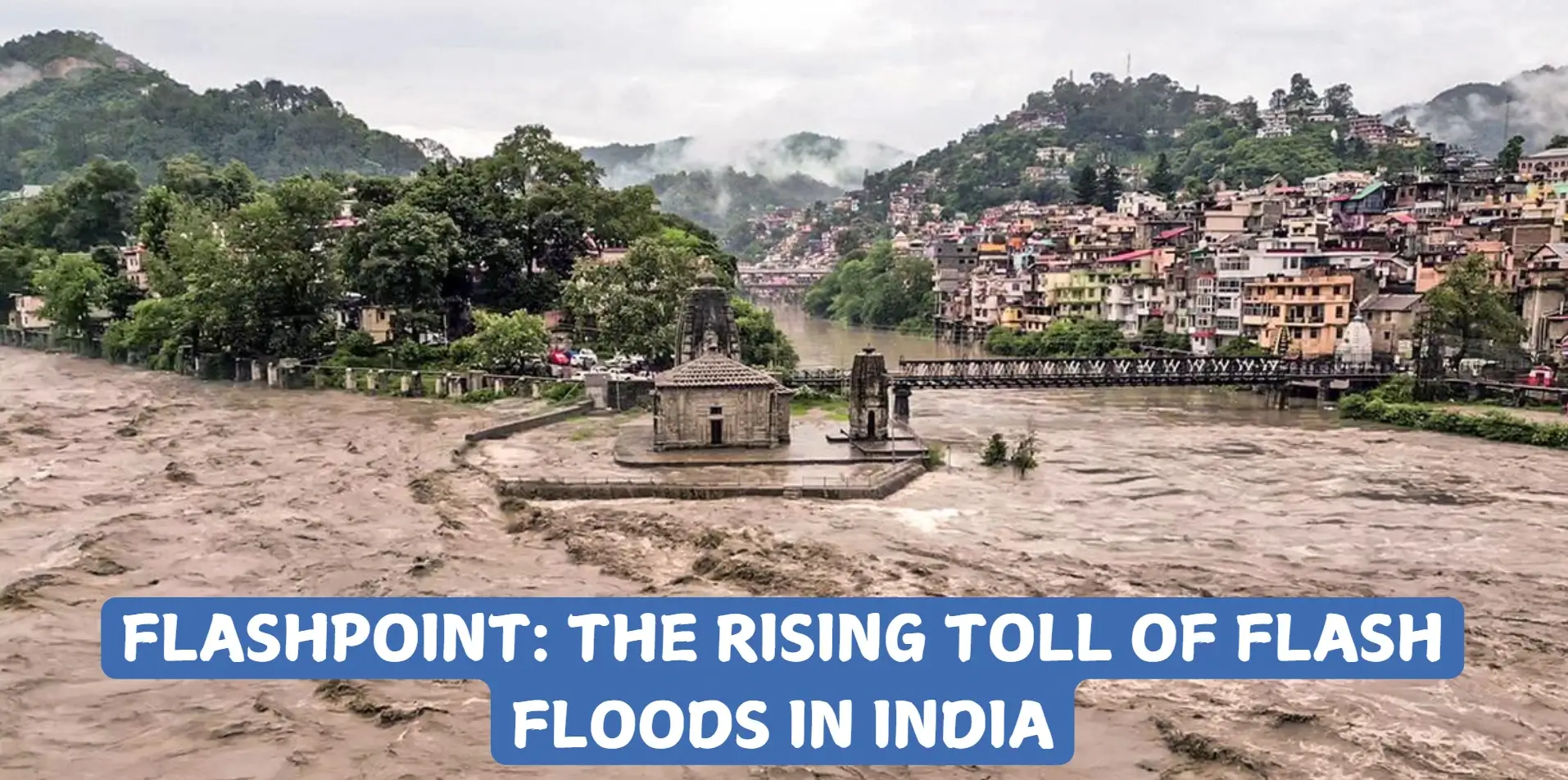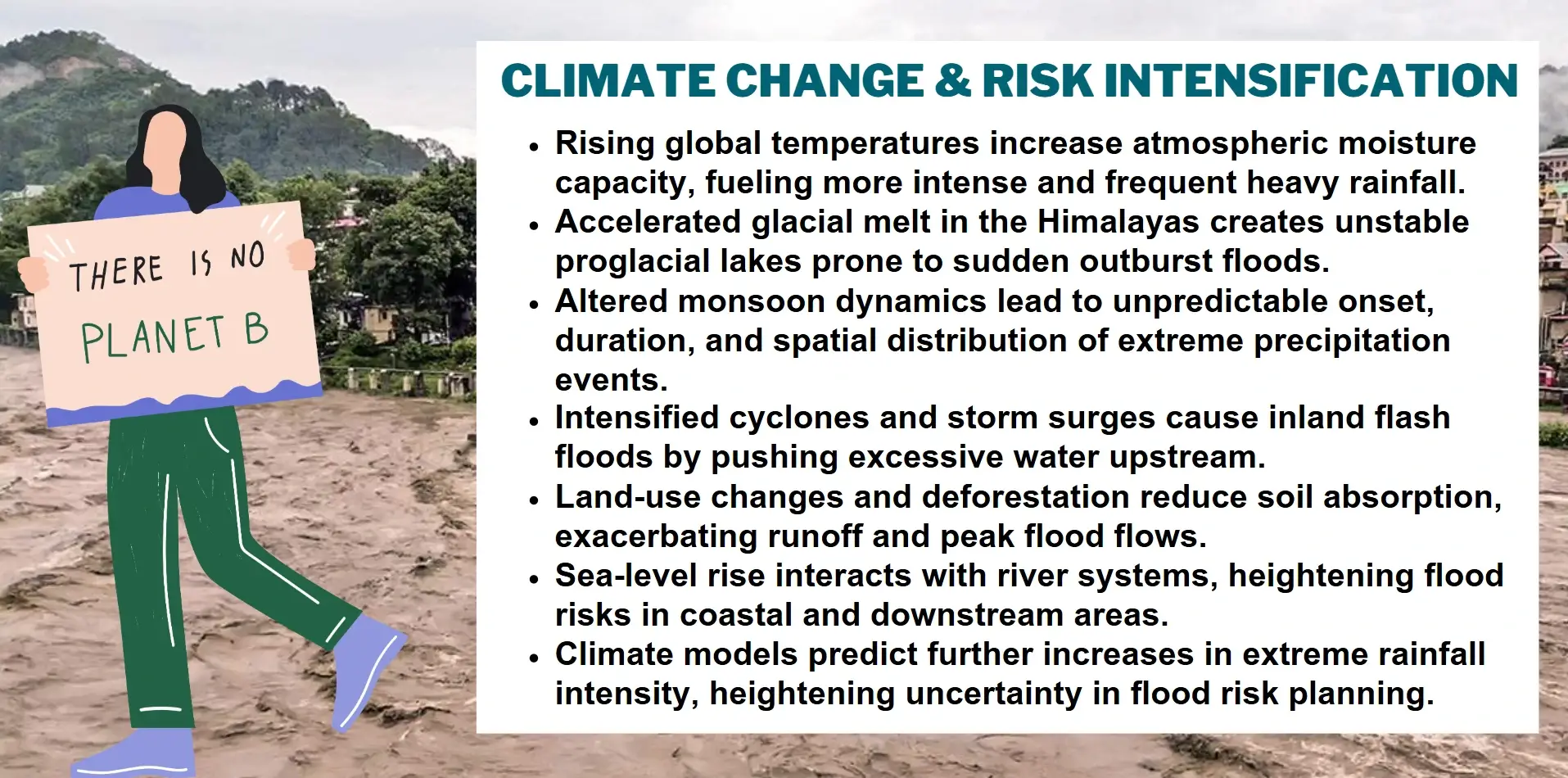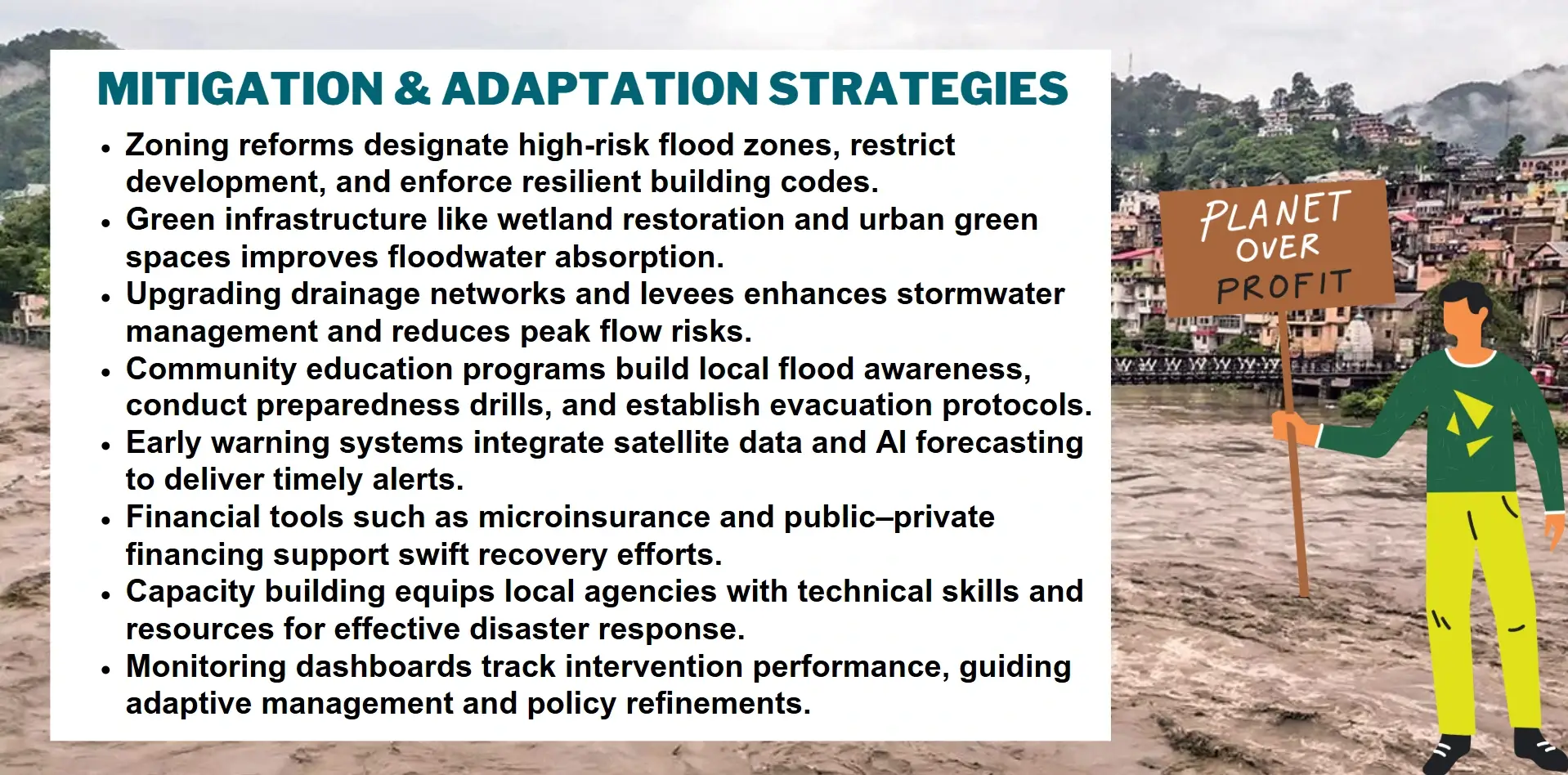In India, more than five thousand people are already killed annually by flash floods, and climate change and infrastructural deficientness increase dangerousness. Reforms are necessary and intelligent planning is highly needed.

The problem of flash floods in India is on the rise, with the number of lives lost in floods reaching over 5,000 and infrastructural damage adding to more damage to homes and farmland. Climate change is increasing and intensifying these sudden deluges that are usually caused by heavy rainfall, glacial lakeoutbursts, or cloudbursts. Weaker communities are disproportionately hit by a lack of proper drainage networks, a lack of proper planningof landuse, and late disaster management, especially those found in the slums of urban areas and far-flung rural areas, when climate patterns change and severe disasters increase.The combination of environment degradation, un-designed growth, and ever-increasing temperatures has made the monsoons in India become fatal events. The hot spot regions due to floods, such as Uttarakhand, Himachal Pradesh, Assam, and Bihar, are now facing emergencies as they already have overloaded local capacity, and this exposes vulnerabilities in national resilience planning.In this article, the systemic reasons for the flash flood emergency in India, which require actions that are climate-smart facilities, real-time prediction systems, and enhanced institutional collaboration, are discussed. It also looks at how the risks can be alleviated in the future through policy reforms, awareness, and ecosystem restoration. By highlighting the issues and remedies, the article demonstrates that it is high time to reconsider the Indian approach to floods in the context of climate change,which are seen as volatile.
Flash Floods
Sudden and high-intensity floods of short duration, e.g.,storm surge floods and flash floodscausing floods are very short bursts of intense floods and usually occur due to a significant amount of precipitation, due to overflowing dams, or due to glacial outbursts. They are highly dangerous and difficult to deal with because they are unpredictable.
What are Flash Floods?
Flash floods are not the same as regular ones; they are much faster and more powerful. They may happen in minutes or hours after some triggering event and race across arid land with terrifying intensity. As opposed to seasonal floods, they are not limited to a geographical location;they can even happen in urban areas, mountainous areas, and deserts. They develop so quickly that not much time is left to leave the area or prevent them.
Reasons for Flash Floods
Its major natural causes are:
- Heavy showers (Showers of a local kind)
- Cloud bursts,especially in mountainous areas
- Glacier lake outburst floods (GLOFs)
- The sudden breaks of dams
The contribution to it by human activity is also big. The risk is enhanced by deforestation, bad land-use patterns, encroachment on riverbanks, and improper drainage mechanisms of the cities.
Social, Economic, and Environmental devastation
Houses, infrastructure and agricultural land can be swept away by flash floods within minutes. The cities experience sewage flooding, breakdown of traffic, and electricity cuts. There is livestock, yield, and residential loss in the rural areas. The human cost is in terms of injuries, disease due to waterborne illnesses, and death, especially of the more vulnerable groups,who lack access to early warnings.
Mitigation and Adaptive Measures
Reduction of risks is possible by enhancing weather forecasting, sensitization of communities,having early warning mechanisms, and the presence of strong infrastructure. Incorporating nature-based remedies such as reforestation, wetland restoration and so forth can assist in reducing the rate of runoff and trapping water. Policy making and planning should also follow the geography and weaknesses of the areaso as to avoid subsequent destruction.
Vulnerability Landscape of India
The evident vulnerability across India to flash flooding is complexwith regard totopography and the nature of extreme climatic constraints, and their relative risk and vulnerability among different regions, which are affected by geography, population density and infrastructure deficits.
Hotspots of Flash Floods
Highly vulnerable due to rough terrain, glaciers and cloud bursts, are the Himalayan range i.e. Himachal, Sikkim,Arunachal and Uttarakhand. In Northeast India there are a lot of rain-fed flash floods and complementarily the capital cities such as Mumbai, Chennai, Bengaluru have had weak drain systems to combat with the torrential rains. Embankment breaches and shoring up cause inundation in the riverine plains of Bihar and Assam, too, which are subjected annually to inundation.
Urban Fragility
The rapid urbanization has caused a higher risk of flash floods in the urban centres. Cement forms a barrier to water absorption, and old stormwater systemscannot cope with intermittent downpours. The informal settlementsthat lie close to riverbanks or low-lying areas lack proper flood protection mechanisms, hence making the residents especially vulnerable. In cities, flash floods do not just paralyze mobility and power, but also flaunt deep inequality in access to infrastructure and disaster preparedness.
Mountain Hazards and GLOFs
Rising temperatures in glacier-fed areas have also led to an increase in the chances of glacial lake outburst floods (GLOFs) where large volumes of melt water amassed upstream are suddenly freed down-valley with great energy. Poor evacuation and relief operations because of limited access routes, low populations, and unstable lines of communication make their evacuation efforts unfavourable. The 2025Himachal event in Mandi highlighted the deadly interplay of climate change, infrastructural construction, and poor geology.
The Mapping of Risk to Resilience
It is not enough to identify these zones, but rather spatially-specific and community-directed adaptation must be on the cards. The vulnerability mapping, when combined with the satellite databases and climatic modelling, can inform zoning codes, pre-disaster warning systems and localized infrastructure planning. The response to threats must also evolve, based on its complex risk environment, with the rapid evolution of the threats that India faces.
Climate Change and Increasing Risk
The threat that climate change poses is now imminent rather than distant, as climate is increasingly becoming a transformativeaction that alters global risk contexts, but in an uneven way, affecting the most vulnerable populations, life forms and weak foundations of infrastructure-related systems within countries.
Hazard Aggravation
The increasing temperatures in the world are even increasing the rate and severity of the extreme events: flash floods, droughts, wildfires, and heat waves. This is not normal variability, but climatologically induced chaos that has a ripple effect on the social and economic impact. Take the example of the warming of oceans, which nourish cyclonic activity combined with the changing monsoons, leading to unpredictable rainfall, which taxes the conventional measures to manage water.
Geographic Inequities
Climate risks are unequally placed. The Bangladesh and India coastal low-lying areas are exposed to multi-hazard risks due to rising sea level and tropical storms. Desertification and water scarcity in arid areas such as western Rajasthan and glacial sceneries like floods and landslides in the Himalayan belt are at risk. The minor contributors to global emissions are the indigenous communities and subsistence farmers who happen to bear the brunt of the adverse impacts.
Weakness of Infrastructure
Aging and poor infrastructure a major causes. Power grids are put under stress due to the heating, and drainage lines get exhausted in the city during cloudbursts. Informal settlements in areas that are prone to floods or those that are unstable are not resilient to the effects of climate, and hence increase human and economic damages in the event of a disaster. In the absence of climate-sensitive design and area-based risk prediction, infrastructure turns out to be a multiplier of vulnerability.

Redesigning Risk Frameworks
Conventional risk models do not fare well in climate variability. The governance has to shift towards the anticipatory adaptation; the application of climate projections in the zoning regulations, finance of disasters and resilient structures. We need integrated planning with community input and adata-driven, turnkey response system to help address increasing risk. Climate resilience is not a policy; it is a strategy to have sustainable futures.
Impact Assessment
Impact assessment is a judgmental tool that helps study the environmental, social and economic consequences of a policy, project and calamity that may inform decision-making, fair development, and the stability of systems.
Environmental Stress Mapping
The impact evaluations assist in determining alterations to the ecosystems brought about by infrastructure developments, mining, farming, and catastrophes. These are modifications of the land cover, loss of biodiversity and pollution of the water. Spatial maps of degradation are then possible using remote sensing tools and GIS technology, with predictive models able to understand long-term harm to critical habitats and natural buffers such as wetlands and forests.
Profiles of Social Vulnerabilities
Socioeconomic evaluations have shown to establish the manner in which various communities bear risk and interference. Marginalized populations are regularly susceptible to a cluster of vulnerabilities, whether through displacement, loss of livelihood or health effects as a result of environmental strains. Adding gender disaggregated statistics and caste-sensitive data analysis can allow policy making to remain inclusive and does not cause a strengthening of social inequalities. Voice from the ground is the process that guarantees mitigation strategies are shaped by participatory appraisal methods.
Economic Dislocation Study
Economic impact cannot be measured by the number of damaged properties. It encompasses indirect losses in productivity, employment change, breakage of supply chains and ripple effects on the economies of an entire region. Such frameworks as cost-benefit analysis (CBA) and environmental valuation methods assist in balancing off the costs and benefits of development against damage to the ecological or social environment, which is needed in sustainable planning.
Governance and Decision Support
The results of strong impact assessments ought to be channelled into decision structures such as environmental clearance mechanisms, land-use plans, and climate adaptation interventions. When combined with climate models and early warning systems they allow governments what most governments fail to do, what to do before the risk occurs not after.
Legislative and Action protocols
Every community has risks to deal with (historically, this has included everything from climate change to cracks in an infrastructure), and in a world where risks are compounded, governance mechanisms and responses should not be reactive in kind but anticipatory, decentralized, and community-based in organization.

Adaptive Institutional Constructs
The top-down disaster governance is becoming inadequate. Contemporary models put more focus on horizontal alignment among ministries, local governments, and civil society. Authorities such as the National Disaster Management Authority (NDMA) are increasing the functions of the institution in order to comply the climatic forecast with real-time information in the planning strategy. Decentralized governance promotes interventions that are dependent on context, particularly different geographies with different risk profiles.
Technology-based early-warning systems
The IMD and the ISRO are using satellite information in the flood, heatwave, and storm predictions. Effectiveness, however, depends on the last-mile connectivity alerts need to reach vulnerable groups in local languages with local action plans. By incorporating technology with the response capabilities on the ground, human and economic loss may be reduced drastically.
Community-Centric Preparedness
The effectiveness of governance is determined by how much it reaches out to its subjects. The engagement of the community in disaster preparedness, according to local task forces, training, and citizen science, generates accountability and trust. When given funds and planning powers, Panchayats and municipal bodies can come up with region-specific solutions collaboratively. Transparency is enhanced through social audits, response drills that are gender sensitive and participatory budgets that meet local needs, which are reflected in the action.
Information Feedback and Dynamic Policy
Feedback loops may be used by post-disaster assessments and open data platforms to narrow down governance strategies. Such frameworks as the Sendai Framework for Disaster Risk Reduction lay emphasis on monitoring, learning and adaptation as fundamental principles. India could support its episodic relief with the embedded flexibility of legal and operational systems to convert short-term solutions to long-term.
Policies and Long-Term Adaptation Strategies
This threat of flash floods needs to be addressable and not merely restricted to emergency response by India: it is a comprehensive, long-term, considerate policy-making architecture needed where resilience can be incorporated in development.
- The existing frameworks, such as the National Disaster Management Plan and State Action Plans on Climate Change, already have a basis, but they tend to lack a local basis and inter-sectoral integration.
- To mitigate the exposure to urban floods, it is possible to update the building codes, implement floodplain zoning and reengineer a drainage system.
- Watershed management, sustainable agriculture and afforestation are in favour of the rural areas.
- Notably, land use policies have to encompass the revised vulnerability analyses on the basis of satellite data, hydrological models, and community-generatedknowledge.
- The key role is played by technologyand these are due to real-time data based on remote sensing, prediction models based on AI, and decentralized alerting allowing proactive governance.
- The constructed nature-based solutions, such as the restoration of wetlands and buffers along rivers, can be used to absorb the excess runoff to reduce disaster effects.
- There should be policies that emphasize the involvement of local governments, women's groups and the roles played by indigenous communities.
- Some of the financial tools that can enable regions to establish tailored resilience include green bonds, disaster insurance, and climate-risk funds.
Mitigating flash floods by integrating the concept of adaptation to the climate into the development agenda of India becomes a long-termecological and social stability as opposed to episodic interventions.
Conclusion
Strategies in India to curb flash floods must be on how to weave long-term adaptation into the cloth of development policy. Reactive strategies cannot continue to support communities that are experiencing the increasing climate volatility. Whether it comes to the transformation of urban and rural space or enabling local governance, the ability of India to be ready in the future depends on shaping its readiness in terms of planning, finance, and infrastructure regarding climate risk.It is not only a technical adaptation: it is social, ecological, and economic. An innovative multi-faceted response to the changing threats is the utilization of AI, nature-based solutions, and local knowledge systems. Such equity of resilience as the inclusion of voices of the marginalized, combined with the institutional changes, should make resilience long-term and durable.This extension of proactive, participatory, and data-based approaches will be the key to the success of the adaptation story in a climate-uncertain world, as India seeks its way to grow. The flash floods can then be not only a challenge, but an increase in the commitment to making democratic decisions and ecological recovery.